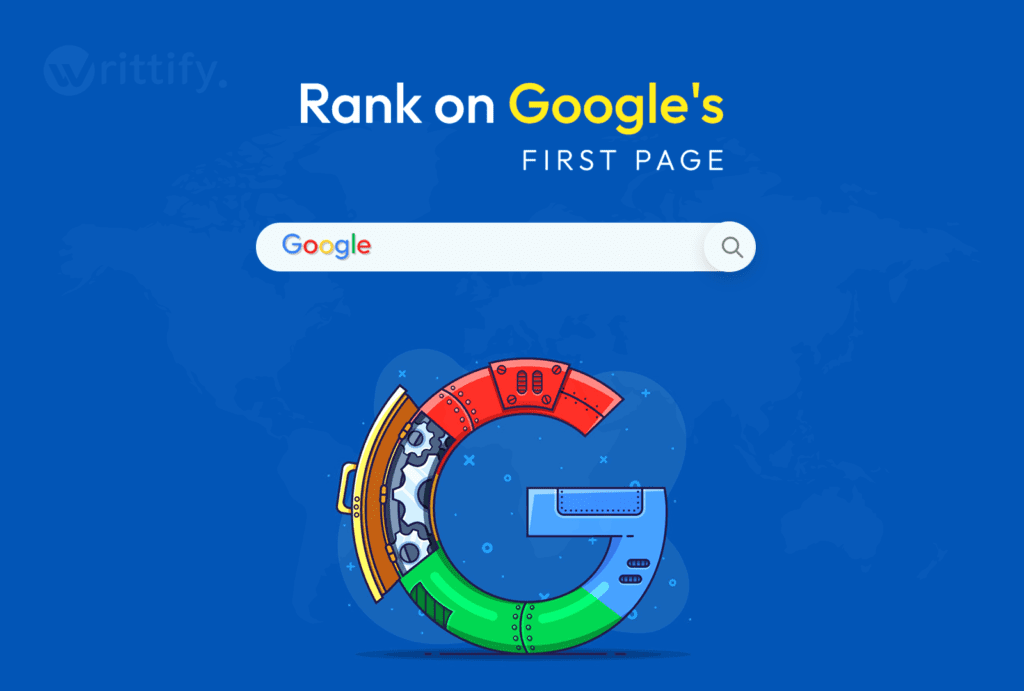The significance of Google SERP ranking and first-page visibility cannot be overstated when it comes to driving website traffic and achieving business success. Websites on the first page of Google’s search results receive the majority of clicks and organic traffic, making first-page ranking a highly desired achievement for businesses and website owners.
This article will explore proven strategies to help you secure a higher position on Google’s search results page through effective SEO techniques. Understanding and implementing these strategies can significantly improve your website’s visibility and attract valuable organic traffic.
Key Statistic: Websites listed on the first page of Google search results capture an average of 71.33% of clicks.
Source: Advanced Web Ranking
This compelling statistic highlights the immense value of securing a prominent position in Google’s rankings. Whether you’re starting a new business or already have an established one, achieving a higher Google rank is crucial for attracting potential customers and growing your online presence.
Throughout this article, we will provide practical tips and actionable insights to help you optimize your website for improved search engine visibility. By following these recommendations, you’ll be able to:
- Understand the importance of SEO in driving organic traffic
- Identify key factors that influence Google’s ranking algorithm
- Implement effective strategies to optimize your website’s on-page elements
- Create high-quality content that resonates with your target audience
- Build authoritative backlinks that signal credibility to search engines
Let’s begin our journey towards better search engine rankings!
1. Understand the Significance of First-Page Rankings
Websites that appear on the first page of Google’s search results receive the majority of clicks and organic traffic. This is supported by relevant data and statistics that highlight the importance of achieving a high SERP ranking. But why is it so crucial? Let’s explore the significance of first-page rankings:
Click-through rates
When users search for a specific query on Google, they are more likely to click on one of the top results displayed on the first page. In fact, studies have shown that the first three organic search results capture around 40% of all clicks. As you move down the search results, the click-through rates decrease significantly.
Brand recognition
Being prominently featured on the first page of Google not only helps drive traffic to your website but also increases brand visibility and recognition. Users are more likely to trust and engage with brands that consistently appear on the first page, associating them with authority and credibility in their respective niches.
Establishing industry authority
A high SERP ranking demonstrates expertise and knowledge in your field. When users find your website among the top results, they perceive you as an authoritative source for information or products/services related to their search queries. This can lead to increased trust, loyalty, and repeat visits from users who recognize your position as a thought leader in your industry.
To illustrate the significance of first-page rankings, consider a study conducted by Backlinko. They analyzed over 5 million search queries and found that websites appearing on the first page of Google’s search results had an average domain authority of 61.8. In contrast, websites on subsequent pages had significantly lower domain authorities. This highlights how a high SERP ranking correlates with greater authority and visibility.
In addition to attracting more clicks, building brand recognition, and establishing industry authority, appearing on Google’s first page also improves your chances of attracting qualified leads who are actively searching for the products or services you offer.
By understanding the significance of first-page rankings, you can better appreciate the importance of implementing effective SEO strategies to improve your website’s visibility and increase your chances of ranking on Google’s valuable first page.
2. Conduct Comprehensive Keyword Research
Keywords: long-tail keywords, search volume, keyword difficulty
Importance of Targeting the Right Keywords
Targeting the right keywords with sufficient search volume and manageable competition is crucial for improving your website’s visibility on Google. By identifying and focusing on the most relevant keywords, you can effectively connect with your target audience and drive organic traffic to your site.
Step-by-Step Guide to Performing Keyword Research
Utilize tools like SEMrush or Google Keyword Planner to conduct comprehensive keyword research. Start by brainstorming a list of seed keywords related to your industry or niche. Then, use these tools to analyze search volume, competition level, and keyword difficulty for each term. This process will help you identify high-potential keywords that align with your content strategy.
Tips for Finding Profitable Long-Tail Variations
Long-tail keywords often present valuable opportunities for ranking on Google’s first page. They are more specific and target a niche demographic, making it easier to rank for these terms. When conducting keyword research, look for profitable long-tail variations that reflect user intent and align with your content offerings. Incorporating these long-tail keywords into your content can significantly improve your chances of ranking higher in search results.
By understanding the significance of targeting the right keywords and following a systematic approach to keyword research using reliable tools, you can lay a strong foundation for enhancing your website’s visibility and attracting organic traffic from search engines.
3. Create High-Quality and Optimized Content
Creating high-quality and optimized content is essential for improving your Google rankings. By producing comprehensive, value-driven content that aligns with user intent and satisfies search queries, you increase the chances of your website appearing on the first page of Google’s search results. Here are some key strategies to help you create high-quality and optimized content:
Research and Understand User Intent
Before creating content, it’s crucial to understand what users are searching for and the intent behind those searches. By identifying the primary goal or problem that users want to solve, you can tailor your content to provide valuable information or solutions.
Produce In-Depth Articles
Google favors in-depth and comprehensive articles that cover a topic thoroughly. Instead of creating short and shallow pieces, focus on providing detailed and insightful information that goes beyond what is readily available. This not only helps improve your chances of ranking but also establishes credibility and authority in your niche.
Optimize On-Page Elements
Optimizing on-page elements such as headings, meta tags, and image alt text can significantly improve keyword relevance and visibility. Use relevant keywords naturally throughout your content, paying attention to the title tag, meta description, URL structure, and heading tags (H1, H2, etc.). However, avoid keyword stuffing as it can harm your rankings.
Example: For a blog post about “best hiking trails in California,” optimize the title tag as “10 Best Hiking Trails in California – Explore Nature’s Beauty.” The meta description should provide a concise summary of what readers can expect from the article.
Include Diverse Media Types
Incorporating diverse media types like images, videos, infographics, or audio can enhance the user experience and make your content more engaging. Visual elements not only break up text but also provide additional opportunities for optimization through image alt text and captions.
Example: If you’re writing a recipe blog post, include high-quality images of the dish at different stages of preparation. Add descriptive alt text to the images, such as “Delicious homemade lasagna with layers of pasta, meat sauce, and melted cheese.”
Craft Compelling Headlines
A captivating headline can attract more clicks from search engine users. Use power words, numbers, and emotional triggers to make your headline stand out. Make sure it accurately reflects the content of your article to avoid misleading readers.
Example: Instead of a generic headline like “Hiking Tips,” try “10 Expert Hiking Tips for Conquering Challenging Trails.”
By implementing these strategies, you can create content that not only satisfies user intent but also improves your chances of ranking higher on Google’s search results page. Remember to focus on providing value, optimizing on-page elements, and engaging readers through diverse media types.
4. Build Authority Through Strategic Link Building
Link building is a crucial aspect of SEO, especially when it comes to building authority and trust with search engines like Google. Earning relevant and authoritative backlinks remains a crucial factor in Google’s ranking algorithm. Here are some key points to consider:
Backlink Acquisition
Quality over quantity is essential when it comes to backlinks. Focus on acquiring links from reputable and relevant websites within your industry or niche. Implementing white hat link-building techniques will ensure that your efforts comply with search engine guidelines.
Guest Blogging
Writing high-quality guest posts for other reputable websites in your niche can help you earn valuable backlinks. This technique not only helps in link-building but also establishes you as an expert in your field. You can learn more about effective guest blogging strategies here.
Link Quality
It’s important to prioritize the quality of the links over the quantity. A few high-quality backlinks from authoritative websites can have a more significant impact on your SEO than numerous low-quality links. This comprehensive guide on white hat link building provides valuable insights into how you can achieve this.
Techniques like resource outreach and broken link building can also be effective in earning quality backlinks from relevant websites.
5. Enhance User Experience and Site Performance
User experience (UX) and site performance play a crucial role in achieving higher rankings on Google’s search results page. Not only do they impact your website’s visibility, but they also influence user engagement and conversion rates. Here are some essential tips to optimize UX and enhance site performance:
Highlight the impact of user experience signals
User experience signals, such as mobile-friendliness and fast loading times, have become increasingly important ranking factors for Google. Mobile optimization is crucial as more users are accessing websites through their smartphones. According to Statista, mobile devices accounted for more than 50% of global website traffic in 2020. Additionally, a study by Google found that 53% of mobile users abandon a site if it takes longer than three seconds to load. Therefore, prioritizing user experience can significantly improve your chances of ranking higher on Google.
Tips for optimizing website performance
To ensure seamless responsiveness across devices and improve overall site performance, consider implementing the following strategies:
- Optimize for mobile: Use responsive web design to ensure your website adapts to different screen sizes and resolutions. Test your website on various devices to ensure it looks and functions well on mobile.
- Improve site speed: Page speed is a critical factor in both user experience and search engine optimization. Use tools like Google PageSpeed Insights or GTmetrix to analyze your website’s speed performance. Minimize HTTP requests, enable browser caching, compress images, and use a content delivery network (CDN) to reduce server response time.
- Optimize code and scripts: Minify CSS and JavaScript files to reduce their size and improve loading times. Remove unnecessary plugins or scripts that slow down your website.
- Enable browser caching: Set appropriate cache-control headers to allow browsers to store static resources, reducing the need for repeated downloads.
Tips for enhancing user experience
In addition to improving site performance, optimizing user experience can increase engagement and improve conversion rates. Here are some tips to enhance user experience:
- Engaging design: Create a visually appealing and intuitive design that aligns with your brand. Use clear navigation menus, readable fonts, and a consistent color scheme to make it easy for users to navigate and find the information they need.
- User-friendly layout: Organize your content in a logical and structured manner. Use headings, subheadings, and bullet points to break up text and make it scannable. Incorporate internal links to guide users to related content on your website.
- Clear call-to-action: Make it easy for users to take the desired action on your website by using clear and prominent call-to-action buttons or links. Whether it’s signing up for a newsletter, making a purchase, or contacting you, ensure that the call-to-action is visible and compelling.
By focusing on mobile responsiveness, site speed optimization, and engaging design, you can significantly improve user experience and site performance. These improvements will not only please your visitors but also increase your chances of ranking higher on
Monitor, Analyze, and Adapt with SEO Tools
Using SEO tools to monitor and analyze data, as well as make adjustments, is extremely important. These tools are crucial for keeping track of how your website is doing, understanding how users are behaving, and making smart choices to improve your search engine rankings.
Popular SEO Tools for Monitoring and Analysis
Here are some well-known SEO tools that can offer valuable information and help you fine-tune your strategies:
- Google Search Console: This free tool from Google provides a lot of data about how your website is performing in search results. It shows you where your site ranks for different keywords, how often people are clicking on your links, and any technical problems that might be hurting your visibility.
- Ahrefs: Known for its extensive backlink analysis features, Ahrefs is a powerful tool for keeping tabs on your link profile, doing keyword research, and analyzing how well your content is doing.
- Moz: Moz offers a range of SEO tools including rank tracking, site audits, and keyword research. Its easy-to-use interface makes it popular among digital marketers.
- SEMrush: Widely used for competitive analysis and tracking keyword rankings, SEMrush gives you valuable insights into both organic search results and paid advertising strategies.
By using these tools effectively, you can:
- Get a better understanding of how your website is performing overall
- Discover specific areas where you can make improvements
- Stay ahead of your competitors in the constantly changing world of SEO
Stay Updated with the Latest SEO Trends and Algorithm Changes
SEO is constantly evolving, and it’s crucial to stay up-to-date with the latest trends and changes in Google’s algorithms. Here are some ways you can stay informed:
- Join online communities: Participate in forums or social media groups where SEO professionals share insights and discuss recent developments.
- Follow reputable SEO blogs: Find trusted sources that regularly publish informative articles on SEO strategies, tips, and news.
- Subscribe to newsletters: Sign up for newsletters from industry experts or authoritative websites that provide regular updates on SEO trends and algorithm changes.
By staying connected to these resources, you’ll be able to adapt your SEO strategies effectively and maintain a competitive edge in search engine rankings.
Conclusion
Achieving a higher rank on Google’s first page is not an unattainable goal. By understanding the significance of first-page rankings, conducting comprehensive keyword research, creating high-quality content, building authority through strategic link building, and enhancing user experience and site performance, you can significantly improve your website’s visibility and attract valuable organic traffic.
Now that you have gained insights into these proven strategies, it’s time to take action. Implement the discussed techniques, stay informed about the latest SEO trends and algorithm changes, and adapt your approach as needed. Remember that consistent effort and a well-planned SEO strategy can lead to tangible results. So, go ahead, apply these 5 easy steps, and increase your chances of securing a coveted position on Google’s first page. Your dedication to these efforts will undoubtedly yield fruitful outcomes for your online presence and business success.
- Chandanhttps://writtify.com/author/chandan/
- Chandanhttps://writtify.com/author/chandan/August 23, 2022
- Chandanhttps://writtify.com/author/chandan/August 23, 2022
- Chandanhttps://writtify.com/author/chandan/August 23, 2022










